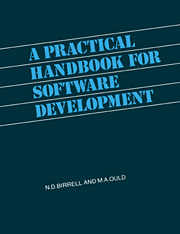Book contents
- Frontmatter
- Contents
- Foreword
- Preface
- 1 The choices facing the system developer
- 2 The software development process
- 3 Development techniques
- 4 Project Inception
- 5 System Definition
- 6 System Design
- 7 System Production
- 8 System Acceptance and Post-Acceptance Development
- 9 Project Debriefing
- Other bibliographies
- References
- Index
2 - The software development process
Published online by Cambridge University Press: 11 January 2010
- Frontmatter
- Contents
- Foreword
- Preface
- 1 The choices facing the system developer
- 2 The software development process
- 3 Development techniques
- 4 Project Inception
- 5 System Definition
- 6 System Design
- 7 System Production
- 8 System Acceptance and Post-Acceptance Development
- 9 Project Debriefing
- Other bibliographies
- References
- Index
Summary
The transformation of your client's ideas about his proposed system into the physical, delivered system is a long one. If this transformation is to be at all manageable, it needs to be tackled as a sequence of stages, each bringing you closer to your destination.
The simplest model of the software development process is a purely sequential one with each succeeding stage following on in serial fashion from the previous one. Such a model could serve for a small one-man project but a better approximation to reality is contained in the so-called ‘cascade’ or ‘waterfall’ model suggested in figure 2.1. This recognises that it is generally necessary – even desirable – for the stages to overlap and even repeat.
It is normally customary at this point to talk of the software development ‘lifecycle’ and to draw a diagram along the lines of figure 2.2. This custom is based on the premise that the original development of a system from scratch has the same underlying sequence of events as the enhancement or correction of a system: inception, definition, design, implementation and acceptance. Superficially this is true but the similarity is slight and the generalisation at times unhelpful.
In this book we prefer to talk about the ‘development path’ and ‘maintenance cycles’ and to draw the ‘b-diagram’ along the lines of figure 2.3. This reflects reality more closely. The development path, starting from nothing more than a desire for a system, stands alone.
- Type
- Chapter
- Information
- A Practical Handbook for Software Development , pp. 3 - 23Publisher: Cambridge University PressPrint publication year: 1985



